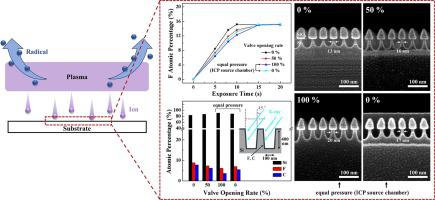Applied Surface Science ( IF 6.3 ) Pub Date : 2021-09-14 , DOI: 10.1016/j.apsusc.2021.151311 Doo San Kim 1 , Yun Jong Jang 1 , Ye Eun Kim 1 , Hong Seong Gil 1 , Hee Ju Kim 1 , You Jin Ji 1 , Hyung Yong Kim 2 , In Ho Kim 2 , Myoung Kwan Chae 2 , Jong Chul Park 2 , Geun Young Yeom 1, 3

|
Radicals generated during reactive ion etching (RIE) cannot be electrically controlled, causing isotropic etching and chemical damage to the sidewall of the etched feature during the etching process. In this study, using a reactive ion beam etcher (RIBE) installed with a dual exhaust system, where an additional exhaust valve was introduced to pump out radicals from the inductively coupled plasma (ICP) source chamber in addition to the conventional main gate valve in the process chamber, the radical flux relative to ion flux during the RIE process has been controlled and the effect of additional exhausting through the ICP source chamber for the control of radical flux relative to ion flux on the properties of etching has been investigated using CF4 gas. The results showed that the additional exhausting of the radicals through the ICP source chamber not only decreased the ICP source chamber pressure but also decreased the ratio of radical flux to ion flux to the substrate. The lower ICP source chamber pressure could be also obtained without additional exhausting through the ICP source chamber by decreasing the CF4 gas flow rate to the ICP source chamber, however, the lower ratio of radical flux to ion flux was observed for the dual exhaust system. It is believed that, for the next generation RIBE, multiple exhausting is beneficial for anisotropic etching of nanoscale features by controlling the radical flux to the sidewall and ion flux to the bottom of a nanoscale feature during the etching.
中文翻译:

双排气系统反应离子束蚀刻 (RIBE) 中的自由基通量控制
在反应离子蚀刻 (RIE) 期间产生的自由基无法通过电学控制,从而在蚀刻工艺期间对蚀刻特征的侧壁造成各向同性蚀刻和化学损坏。在这项研究中,使用安装有双排气系统的反应离子束蚀刻机 (RIBE),除了传统的主闸阀外,还引入了一个额外的排气阀,以从电感耦合等离子体 (ICP) 源室中抽出自由基。在工艺室中,RIE 工艺过程中相对于离子通量的自由基通量已经得到控制,并且已经使用 CF 4研究了通过 ICP 源室进行额外排气以控制相对于离子通量的自由基通量对蚀刻特性的影响气体。结果表明,通过ICP源室额外排出自由基不仅降低了ICP源室压力,而且降低了基片的自由基通量与离子通量之比。通过降低进入 ICP 源室的 CF 4气体流速,也可以在不通过 ICP 源室进行额外排气的情况下获得较低的 ICP 源室压力,但是,观察到双排气系统的自由基通量与离子通量的比率较低. 相信对于下一代RIBE,通过在蚀刻过程中控制到侧壁的自由基通量和到纳米级特征底部的离子通量,多次排气有利于纳米级特征的各向异性蚀刻。











































 京公网安备 11010802027423号
京公网安备 11010802027423号